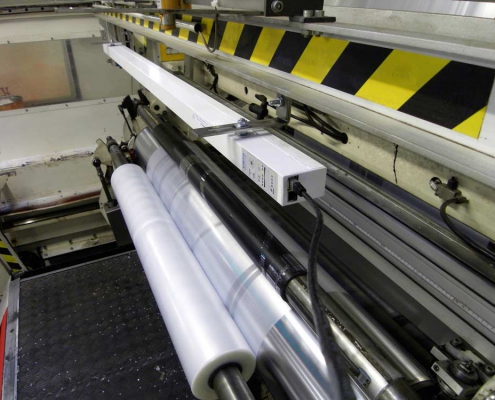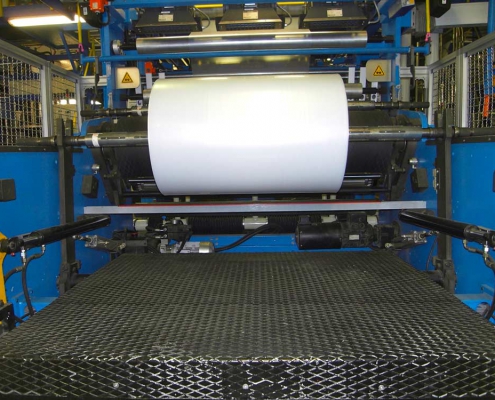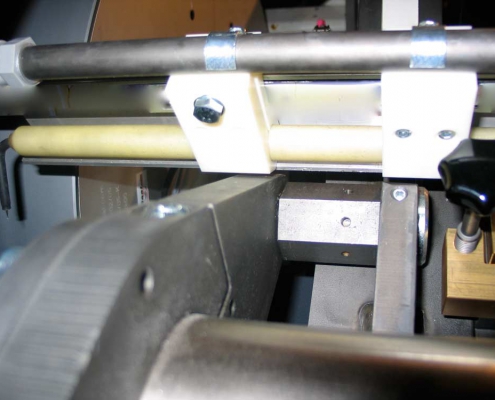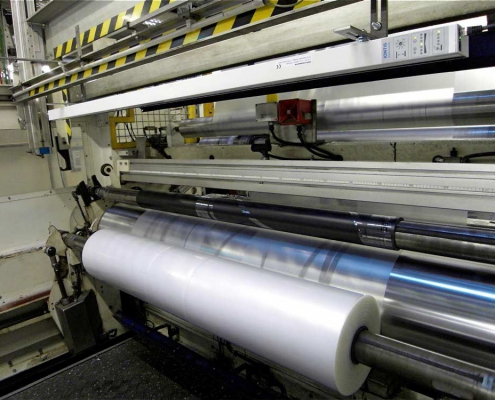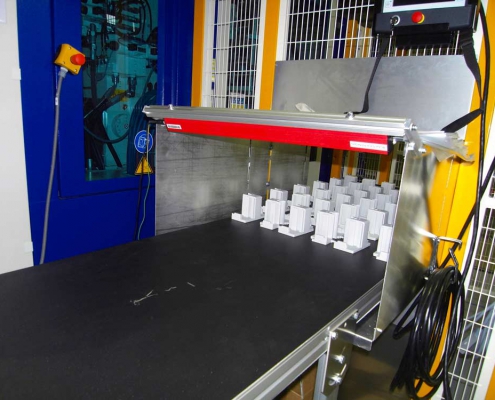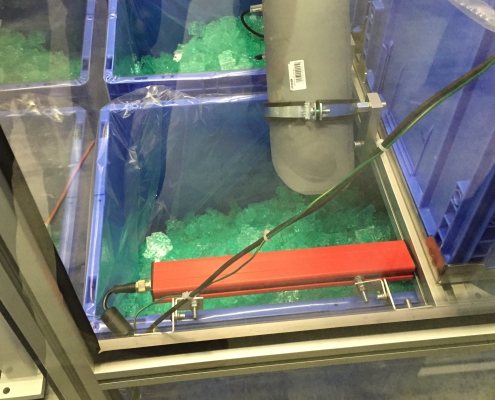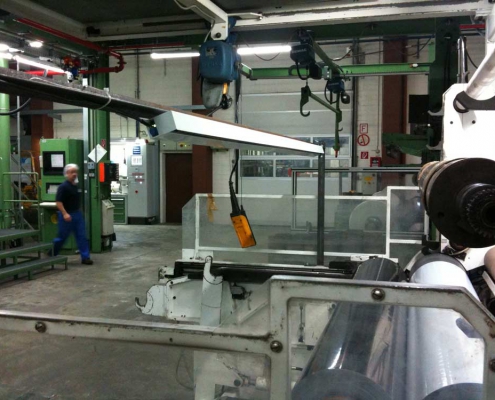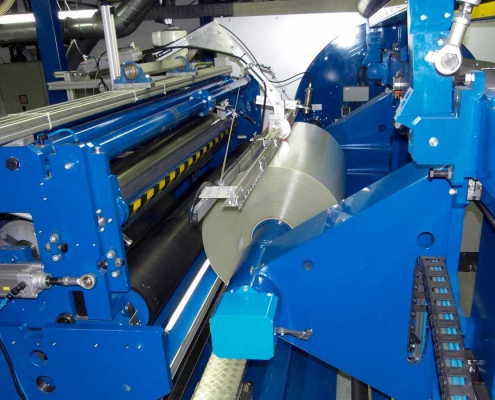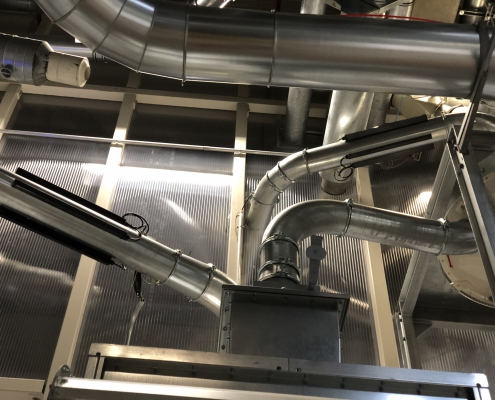Plastics
Typical application examples for neutralisation and charging
Typical application examples for neutralisation and charging
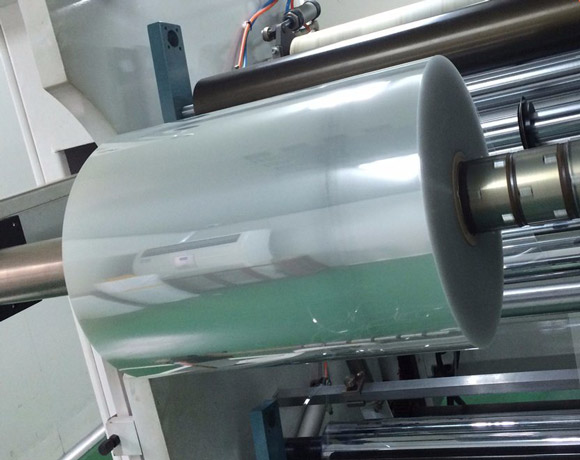 The chemical nature of the plastics makes them susceptible to charging. Usually the amount of charge in plastic processing is so high that active discharge is necessary to enable the work processes.
The chemical nature of the plastics makes them susceptible to charging. Usually the amount of charge in plastic processing is so high that active discharge is necessary to enable the work processes.
IONTIS products are already being used in subsequent processes for both discharging and charging:
Cast Film Production |
In cast film lines, an electrostatic charging can improve the heat transfer when the melted pulp meets the chill-roll.
In cast film extrusion an electrostatic edge strip charging provides an adhesion of the film edges on the roller and prevents a “neck-in” of film. After a corona treatment and/or the calandering, most often the film has a strong charge with undesired effects (e.g. dust attraction) if not properly neutralised. For the initial winding of the film an applied static charge to the rollers can generate an adhesion without the need to use tape for fixation. |
Thermoforming |
The electrostatics created by thermoforming and cooling are eliminated with antistatic bars after the process to prevent stacking problems and dust attraction.
In inline systems, both sides of the film are discharged/neutralised before forming or closing, so the seal will not contain impurities. |
InMould-Labelling |
The label to be applied is charged with a charging ioniser, to place it correctly in the form and ensure precise fixation with no slipping in the forming process. |
Flexoprint |
Built-up electrostatic charge can be removed before printing with antistatic bars and, if necessary, air support to remove disturbing cutting residues and dust. |
Slitting and Cutting |
During slitting of film, an anti-static bar can neutralise the occurring charge immediately after the blade roller and thus ensures safe and clean subsequent processing. For the initial winding of the film on the other hand, an applied static charge to the rollers can generate an adhesion without the need to use tape for fixation.
In cross-cutting of film, an anti-static bar placed right after the cutter can neutralise occurring charge and prevent problems in subsequent stacking. |
Pneumatic Transport |
Neutralisation via tube ionisation or ring electrode allows for a trouble-free transport of solid parts in tubes with the use of pressurised air (e.g. trim waste and foil remnants at the inlet of cyclones or prior to the mill). |
Blown Film Production |
The extrusion process of blown film generates a static charge, which is further amplified by it passing pulleys and rollers: it needs neutralising ionisers before/during winding-up. |
Flowpack & Bag Film Production |
The occurring charge in the flowpack films production needs to be neutralised via anti-static ionisers, to ensure the bags can be opened later and stacked/placed properly – prior to a reel change however, a deliberate charging of the film tube can ensure better carrying in the subsequent steps.
To avoid repulsion of bags from stacks and ensure precise alignment at automatic bag machines, the light-weight plastic material needs to be statically neutralised. Occurring charge is disturbing at the inlet and vane, but also in placing and stacking at a stapler/wicketer and thus needs neutralising ionisation. |
Injection Moulding |
Moulded Parts can become charged during the cooling process and stick to the form, thermoset material can also produce flash/flakes which remains sticked to the form: the form parts are via ionising nozzles neutralised and blown free.
At the outfeed belt and/or conveyor belts charged parts can adhere and lead to blockages and need to be neutralised with ionisers. |
Lining & Laminating |
Moving web can become charged and need a neutralisation with an anti-static bar before the printing or laminating station in order to ensure safety and productivity.
In the coating process, static neutralisation prevents the formation of unwanted structuration on the surface of the varnish. Lamination e.g. during the melamine coating a systematic application of charge to the surfaces can avoid slippages of the film and layers and also ensure a bubble-free surface even at high speeds. |
Winding and rewinding |
Moving film which becomes charged passing rollers and pulleys needs static neutralisation at the contact/surface and turret winder for a subsequent clean, trouble-free processing and to avoid streaking.
However, deliberate systematic charging of the material directly at the turret winder can allow for precise alignment of the edges even of smooth film, an exact fixation at the winders core and a tape-less initial winding of flat film. Additionally a telescoping of the roll can be prevented. |
IONTIS Elektrostatik GmbH
Friedrich-Rottra-Str. 66
D-79588 Efringen-Kirchen
Wir verwenden Cookies. Durch das weitere besuchen dieser Website akzeptieren Sie die Verwendung von Cookies.
Einstellungen akzeptierenNur diese Nachricht verbergenEinstellungenWe may request cookies to be set on your device. We use cookies to let us know when you visit our websites, how you interact with us, to enrich your user experience, and to customize your relationship with our website.
Click on the different category headings to find out more. You can also change some of your preferences. Note that blocking some types of cookies may impact your experience on our websites and the services we are able to offer.
These cookies are strictly necessary to provide you with services available through our website and to use some of its features.
Because these cookies are strictly necessary to deliver the website, refuseing them will have impact how our site functions. You always can block or delete cookies by changing your browser settings and force blocking all cookies on this website. But this will always prompt you to accept/refuse cookies when revisiting our site.
We fully respect if you want to refuse cookies but to avoid asking you again and again kindly allow us to store a cookie for that. You are free to opt out any time or opt in for other cookies to get a better experience. If you refuse cookies we will remove all set cookies in our domain.
We provide you with a list of stored cookies on your computer in our domain so you can check what we stored. Due to security reasons we are not able to show or modify cookies from other domains. You can check these in your browser security settings.
These cookies collect information that is used either in aggregate form to help us understand how our website is being used or how effective our marketing campaigns are, or to help us customize our website and application for you in order to enhance your experience.
If you do not want that we track your visit to our site you can disable tracking in your browser here:
We also use different external services like Google Webfonts, Google Maps, and external Video providers. Since these providers may collect personal data like your IP address we allow you to block them here. Please be aware that this might heavily reduce the functionality and appearance of our site. Changes will take effect once you reload the page.
Google Webfont Settings:
Google Map Settings:
Google reCaptcha Settings:
Vimeo and Youtube video embeds:
The following cookies are also needed - You can choose if you want to allow them:
You can read about our cookies and privacy settings in detail on our Privacy Policy Page.
Datenschutzerklärung
